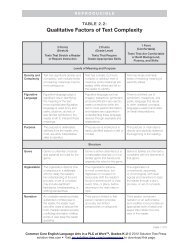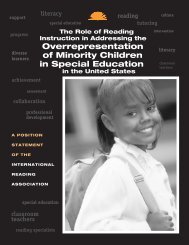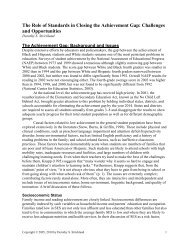Global Education Digest 2012 - International Reading Association
Global Education Digest 2012 - International Reading Association
Global Education Digest 2012 - International Reading Association
You also want an ePaper? Increase the reach of your titles
YUMPU automatically turns print PDFs into web optimized ePapers that Google loves.
OPPORTUNITIES LOST: THE IMPACT OF GRADE REPETITION AND EARLY SCHOOL LEAVING<br />
Gross outbound enrolment ratio. Total number of tertiary students from a given country studying abroad<br />
expressed as a percentage of the population of tertiary age in that country.<br />
Instruction time of teachers (teaching time). Statutory instruction time (sometimes also referred to as teaching<br />
time) is defined as the total number of hours per year for which a full-time classroom teacher is responsible for<br />
teaching a group or class of students, according to the formal policy in the specific country. Periods of time<br />
formally allowed for breaks between lessons or groups of lessons may be excluded. Instruction/ teaching hours<br />
per year are calculated on the basis of teaching hours per day multiplied by the number of teaching days per<br />
year, or on the basis of teaching hours per week multiplied by the number of weeks per year that the school is<br />
open for teaching. The number of hours per year that fall on days when the school is closed is excluded.<br />
Intended instruction time for students. The number of hours per year that pupils are instructed according to<br />
the compulsory and flexible part of the intended curriculum. The total number of intended instruction hours per<br />
year is calculated by multiplying the total number of classroom sessions per year by the duration of one session.<br />
The intended curriculum is the subject matter content, as defined by the government or the education system.<br />
The intended curriculum comprises compulsory subjects, as well as the flexible part of the curriculum (subjects<br />
of the intended curriculum).<br />
<strong>International</strong> (or internationally mobile) students. Students who have crossed a national or territorial border<br />
for the purpose of education and are now enrolled outside their country of origin.<br />
<strong>International</strong> Standard Classification of <strong>Education</strong> (ISCED). A classification system that provides a<br />
framework for the comprehensive statistical description of national educational systems and a methodology that<br />
translates national educational programmes into internationally comparable levels of education. The basic unit<br />
of classification in ISCED is the educational programme. ISCED also classifies programmes by field of study,<br />
programme orientation and destination (see Annex B).<br />
Literacy. The ability to read and write, with understanding, a simple statement related to one’s daily life. It<br />
involves a continuum of reading and writing skills, and often includes basic arithmetic skills (numeracy).<br />
Literacy rate. Total number of literate persons in a given age group, expressed as a percentage of the total<br />
population in that age group. The adult literacy rate measures literacy among persons aged 15 years and older,<br />
and the youth literacy rate measures literacy among persons aged 15 to 24 years.<br />
Mobility ratios<br />
Inbound mobility rate. Total number of students from abroad studying in a given country, expressed as a<br />
percentage of total tertiary enrolment in that country.<br />
Outbound mobility ratio. Total number of students from a given country studying abroad, expressed as a<br />
percentage of total tertiary enrolment in that country.<br />
Net enrolment rate (NER). Total number of pupils or students in the theoretical age group for a given level of<br />
education enrolled in that level, expressed as a percentage of the total population in that age group.<br />
Net flow of mobile students. The number of tertiary students from abroad (inbound students) studying in a<br />
given country minus the number of students at the same level from a given country studying abroad (outbound<br />
students).<br />
67

















